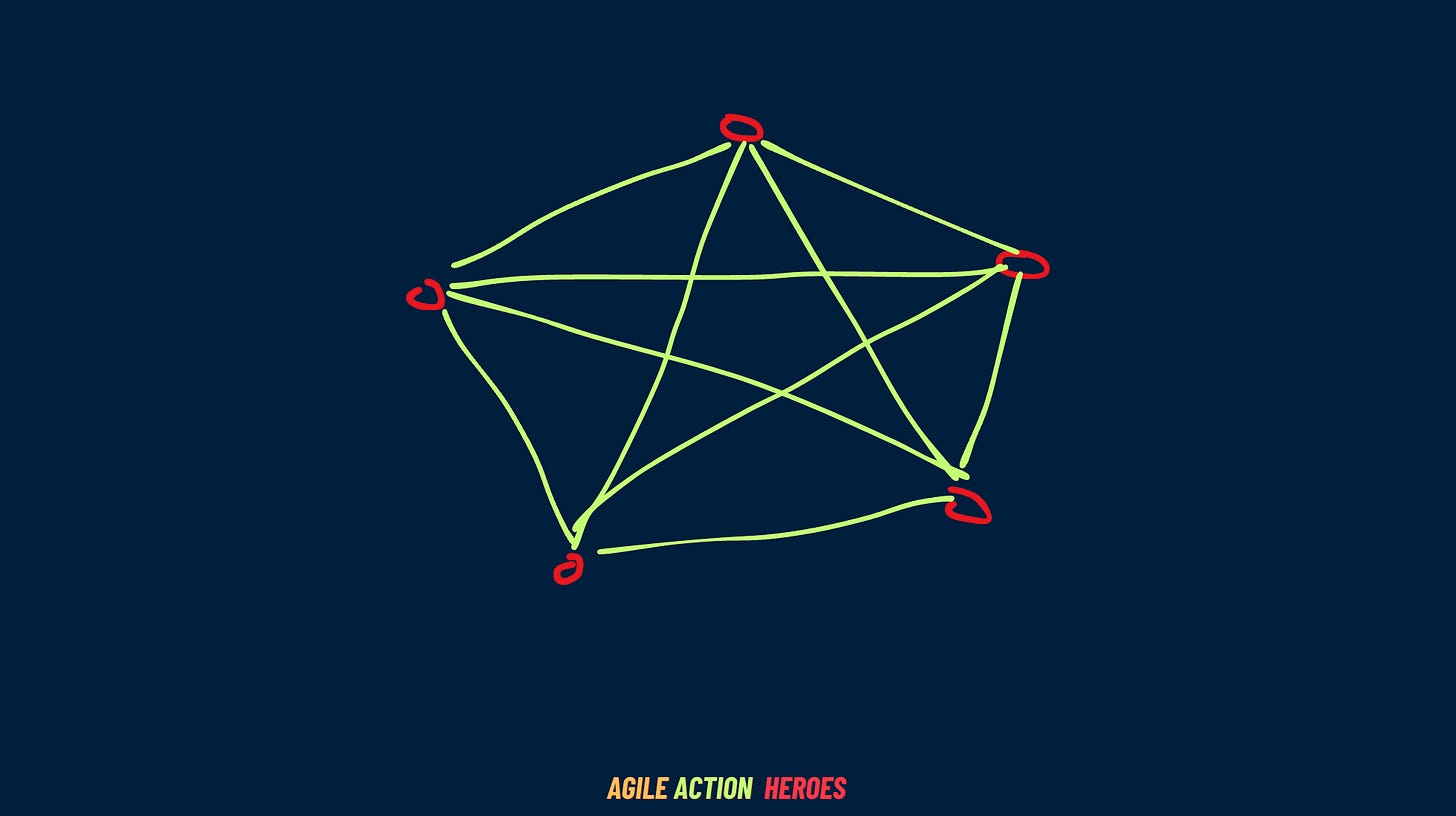Comcon Networks for Agile Teams: Open Communication, No Overload?
Effective communication is the backbone of your team’s success. But have you ever thought about the structure of that communication?
Introduction
As an agile leader, effective communication is the backbone of your team’s success. But have you ever thought about the structure of that communication?
Enter the Comcon network — a fully connected, decentralized structure where every team member can communicate directly with every other member.
If you haven’t heard of it before, don't worry! I will explain now.
What is a Comcon Network?
In a Comcon network, every person is equally connected to everyone else, much like a cross-functional agile team where all voices are valued equally.
Picture it as a roundtable where there is no "head of the table"—everyone can freely exchange ideas and information with everyone else.
This open communication structure is decentralized, meaning there's no central authority or hub controlling the flow of information.
It’s like having a team where everyone is empowered to contribute their expertise, allowing for more creative problem-solving and faster iteration.
Sounds a lot like Agile Teams, right?
The Advantages for Agile Teams
Better Problem-Solving for Complex Tasks
When your team is dealing with intricate problems, the Comcon network shines. Similar to a sprint review where everyone’s feedback is crucial, each team member shares their knowledge freely. This diversity of input leads to a richer understanding of challenges and more innovative solutions.
Higher Team Satisfaction
Agile principles emphasize shared ownership, and Comcon networks mirror this. Without a hierarchy, everyone feels that their contributions matter. It’s like an agile team where there’s no single "boss" making all the decisions—everyone's voice is heard, increasing engagement and satisfaction.
The Downside: Information Overload
However, just like an overfilled backlog can slow down a sprint, a Comcon network can lead to information saturation.
As the number of team members grows, or as tasks become more complex, the constant exchange of information can overwhelm the team.
Think of a daily stand-up that goes on too long because everyone shares too much detail.
This can lead to:
Decreased Efficiency. The more information team members need to process, the slower their decision-making becomes, just like trying to prioritize an endless list of user stories.
Increased Errors. With so much information flying around, it's easy to miss critical details, much like a sprint where important tasks are forgotten because there’s too much on the board.
How to Avoid Information Saturation
As a facilitator, your job is to ensure the team doesn’t get bogged down by too much communication. Here’s how you can keep the flow of information productive:
Break Down Complex Tasks. Just as you’d break down large user stories into smaller tasks in a sprint, break down the conversation. Focus on smaller, more manageable pieces of information to keep everyone from feeling overwhelmed.
Use Agile Tools to Organize Communication. Tools like Jira or Trello are perfect for structuring communication in a way that’s easy to manage. They help team members focus on what’s important, much like a well-groomed sprint backlog.
Why Comcon Networks Might Be Right for Your Team
Not all communication networks are created equal. A Comcon network is great for agile teams dealing with complex tasks because it leverages the diverse perspectives of everyone on the team.
However, for larger groups or simple tasks that require quick decision-making, other network structures might be more efficient.
It’s somehow like choosing between a Scrum board for complex, iterative work and a Kanban board for ongoing, straightforward tasks.
Conclusion: Lead with Open Communication, Avoid the Overload
For agile leaders understanding the Comcon network and its risks can be a game-changer. It promotes open, transparent communication that empowers your team, just like in an agile environment.
But remember, too much communication can slow down progress. By guiding your team through structured, manageable discussions and leveraging the right tools, you can help them collaborate more effectively and prevent overload.
With these facilitation skills, you’ll not only keep your team on track, but you’ll also boost their satisfaction and efficiency—accelerating your career as a skilled agile leader.
Have you experience Information Saturation? What did you do about it?
Share your thoughts and experiences in the comments below!
Ready to take your agile leadership to the next level with facilitation as the future skill #1?Join Agile Action Heroes, a growing community of passionate agile enthusiasts just like you. Get access to exclusive resources, expert advice, and peer support that will help you sharpen your skills and lead your teams with confidence. Whether you're looking for guidance, inspiration, or collaboration opportunities, you'll find it here.🔗 Join Agile Action Heroes Now!Resources for deep dive
Group Dynamics (2009) - Donelson R. ForsythDonelson R. Forsyth


